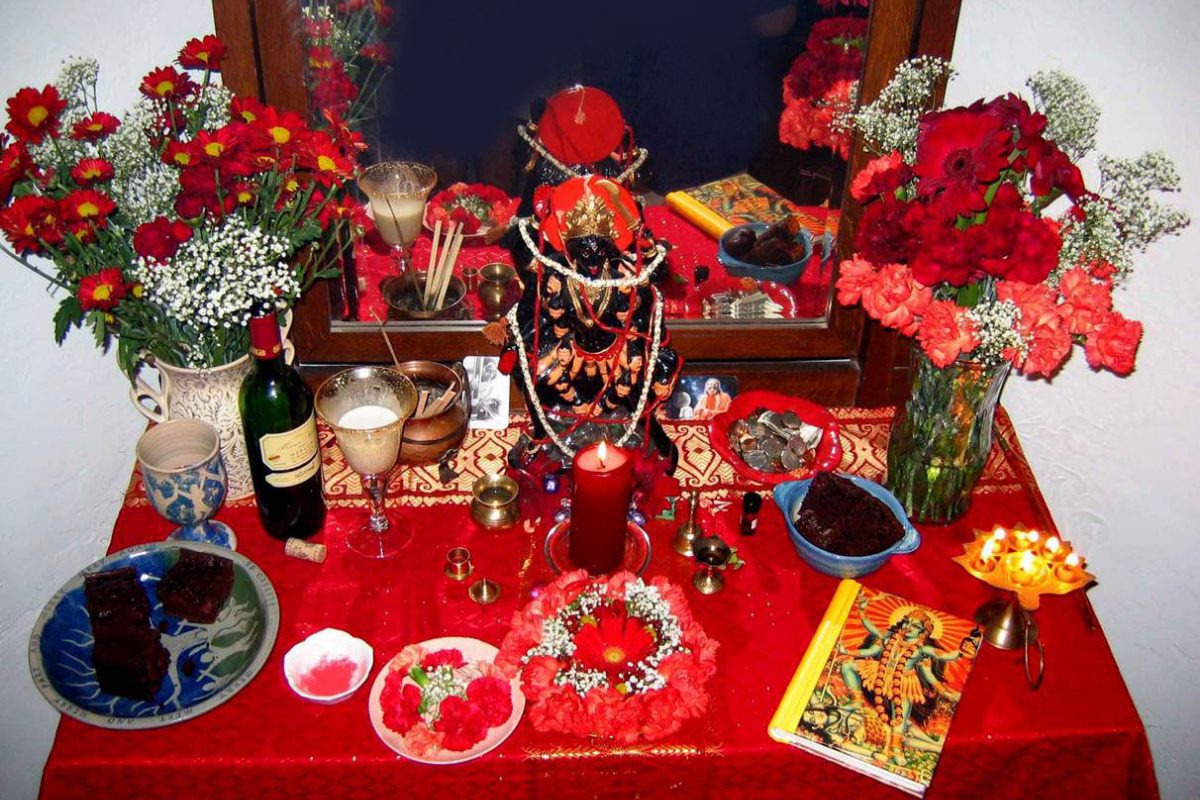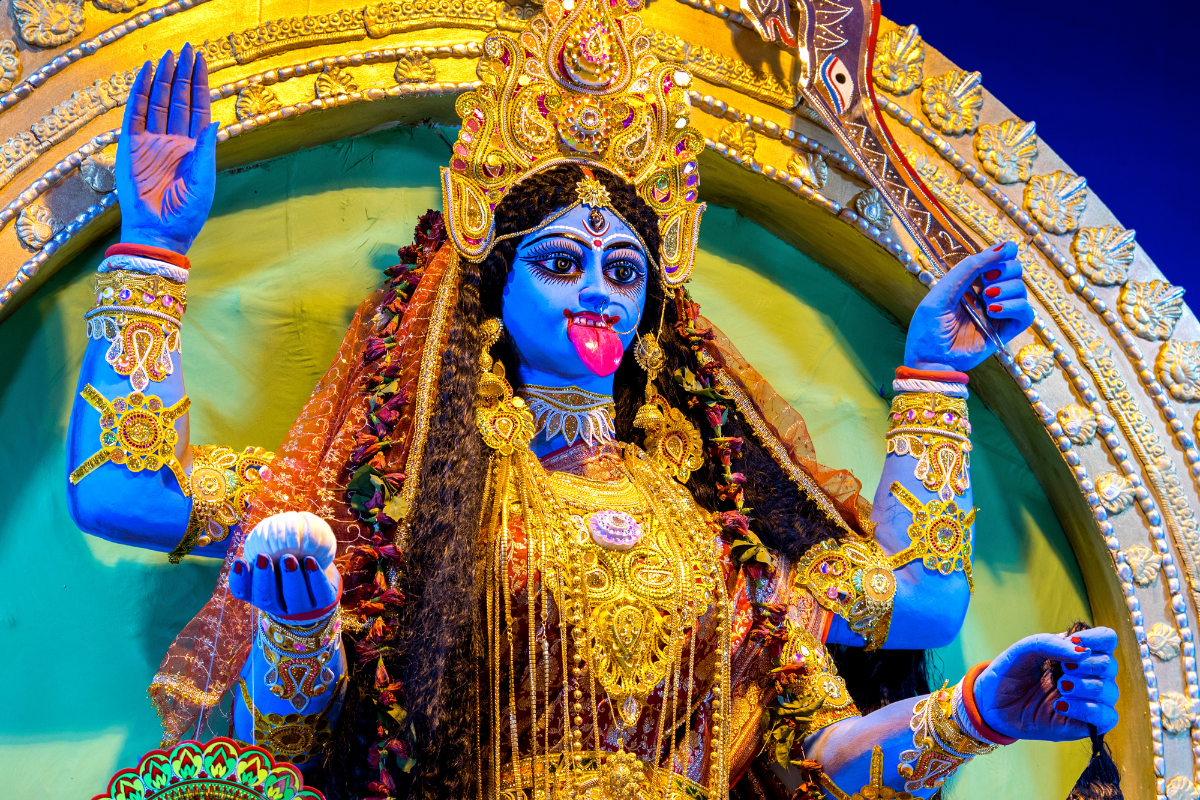The Hindu goddess Kali is one of the most well-known goddesses in the Hindu pantheon. She is revered as a fierce and powerful deity associated with creation, destruction, and liberation. In this article, I offer ideas for worshipping the Hindu goddess Kali and advancing your practice.
The goddess Kali has been essential to my pantheon for many years. The following is based on my understanding and devotional approach to Kali. To her, I dedicate my fires of creation and destruction. I pray to her to grant me her boundless freedom, remove my illusions, and burn away my ignorance and limitations.
Learn about Kali's origins and iconography
One significant first step in worshipping Kali is to learn about her legends and iconography.
Like many deities, Kali has different origin stories. Read a few of these and see which story resonates with you. My favourite legend tells of Kali’s birth from the brow of Durga during a battle against the demon Raktabīja. Every drop of Raktabīja’s blood created a duplicate of the demon, and countless clones appeared on the battlefield. Kali opened her mouth, rolled out her tongue, caught the drops of Raktabīja’s blood, and the goddesses defeated the demon.
Many people find Kali’s appearance frightening, which has led to misunderstandings about her nature. Everything about Kali’s appearance–her dark skin, wild hair, and the garland of severed heads, for instance–has meaning and tells us something about her character and cosmic functions. Studying these symbols will help you better understand her power and significance.
According to various traditions, Kali has 8, 12, or 21 different forms. Begin with the famous classic depiction of the four-armed Kali. Then explore Mahakali, the greatest Kali, a form with ten heads, ten arms, and ten legs. To advance your practice, consider other forms of the goddess Kali, such as:
- Chamunda, the slayer of demons
- Dakshinakali, the mother of mercy and the most popular form of Kali in Bengal
- Samhara Kali, the most dangerous and powerful form of Kali and chief goddess of Tantric texts
In addition to the anthropomorphic representations of Kali, there is a yantra, a geometrical diagram from the tantric traditions, to represent Kali. Studying, making, and working with a yantra is another way to advance your practice.
Create a sacred space for worship

In my experience, Kali is not a demanding goddess. She is always there when I look for her, but she doesn’t demand anything more than love and devotion in your heart. Nevertheless, as Kali has been a part of my life for many years, I have a permanent shrine for her.
Create a sacred space where you can worship Kali. Sacred space can be a small altar or shrine, permanent or one that you build and dismantle as needed. I recommend a red or black cloth (I prefer red), a statue or other image of Kali, and a candle (I use a black pillar). Make offerings to her. These can be simple such as water, incense, and rice. Kali also likes red flowers (the red hibiscus is her favourite), red fruits, and sweets.
As your practice advances and deepens, you may want to purchase a puja thali set. Puja is ritual worship, and a puja thali is a metal tray that holds your puja materials. These include a bell, bowls, an incense holder, religious powders, and ritual thread. I see puja thali sets in Indian stores around Diwali, the annual festival of lights, and you could also purchase one online.
Develop a regular practice
Developing a regular practice is an integral part of any devotional relationship with the divine. Get started simply with meditation, chants, and mantras.
One simple mantra is “Om Kring Kalikaye Namah”. It is a sound representation of the goddess Kali that is said to transform the devotee to pure consciousness.
You could use a mala to assist you in your chanting. Malas made of Rudraksha seeds are common and easy to find. Red sandalwood and coral malas are also good options for Kali. You could also use bone, lava stones, or gemstones; skull malas are popular. A mala with 108 beads is traditional.
To advance your practice, perform puja (ritual worship). The purpose of puja is to connect spiritually with the deity, manifesting in the image and treated like a special guest. Puja engages all the senses and has 16 steps (sometimes more), but devotion and good behaviour are more important than rigid procedures.
More often than not, I perform a simple puja of meditation, invocation, and five elemental offerings. I always include arti, the ceremony of light involving waving a lamp before the goddess to infuse the flames with her energy and blessings. Just as everything in Kali’s image means something, every step in puja has meaning and sentiment. Investigate these to deepen your practice.
Kali is typically celebrated on the New Moon. My New Moons are my busiest Moons. I perform an extensive monthly cleansing and purification, tarot readings, Hecate’s Noumenia, and ancestor work. I perform my Kali puja a day or two before or after the New Moon.
Explore Shaktism and tantra
Advancing practitioners soon realise that Skaktism and tantra can’t be separated, and in the worship of Kali, you engage in both.
Shaktism regards the primordial cosmic energy, or supreme godhead, as female (Shakti). The focus of worship varies, and goddesses in Shaktism include Durga, Parvati, Lakshmi, Sarawati, and, of course, Kali.
The West strongly associates tantra with esoteric sexual practices, but this is the result of colonialism. There is no universally accepted definition of tantra; it refers to the accumulation of ideas and techniques from different sources, including texts, visualisations, mantras, and yoga.
One of the characteristics of tantra is that its rituals transgress existing social and religious boundaries. In the tantric worldview, Shakti animates material reality. A goddess like Kali, violent, erotic, and maternal, challenges the traditional models of womanhood. Poets scold and berate Kali for her shamelessness and dominance. Kali, and tantra, balance tension.
Today, tantra is practised under the guidance of a qualified teacher, and it involves initiation. So, some practices will be closed for most of us, but note that this is a later development that I consider a part of the patriarchy. The origins of tantra lie outside Vedic religion, in the cults of local village goddesses and the practices of female master practitioners called yoginis.
More ways to advance and deepen your practice
There are many ways to learn more about the goddess Kali and deepen your practice.
Observe the annual Kali Puja. This year, it’s on Sunday, 12 November, the same day as Diwali.
Read devotional poetry. I recommend Singing to the Goddess: Poems to Kali and Uma from Bengal by Rachel Fell McDermott.
Learn about chakras. Chakras are nodes of energy that connect energy channels in our subtle body (the psychological, emotional, and mental part of ourselves, as opposed to our physical body). The tantric tradition seeks to master them through kundalini yoga, a form influenced by Shaktism.
As with everything involving Hinduism, there are differences between the Hindu (and Buddhist) ideas of the chakras and yoga and those of the West. For example, some attributes, such as the rainbow colours and associations with other systems, such as astrology and gemstones, are later, Western additions.
Connect with a community. Worshipping Kali can be a deeply personal practice, but it can also be helpful to connect with others who share your interest in this goddess. You can join a local Hindu temple or spiritual community, attend Kali puja celebrations or other events, or connect with other worshippers online. By connecting with others who share your passion for Kali, you can deepen your understanding of this goddess and gain support and encouragement on your spiritual journey.
Worshipping Kali can be a powerful way to connect with the divine feminine and tap into a source of transformative energy. By learning about Kali’s origins and iconography, creating a sacred space for worship, and developing a regular practice, you can develop a deep and meaningful relationship with this powerful goddess.

